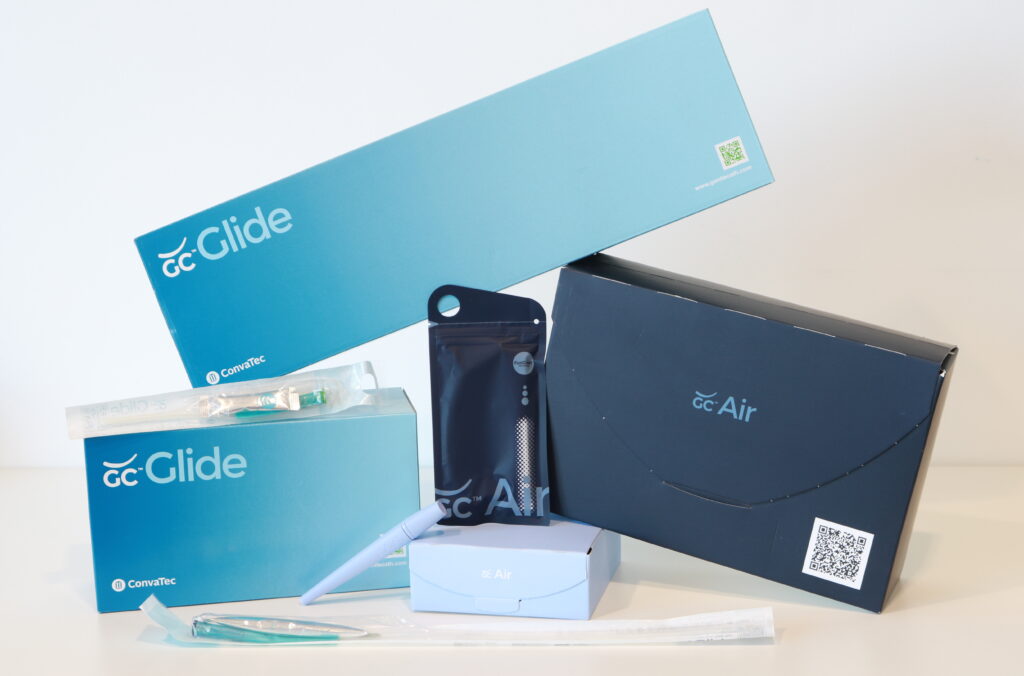Forever Caring
At Convatec, ‘forever caring’ is our promise to give patients and healthcare providers the support they need as we bring to life our vision of pioneering trusted medical solutions to improve the lives we touch.
Existing complications of traditional coated hydrophilic Intermittent Catheters
Clean intermittent self-catheterisation (CISC), while straightforward for some, can be both difficult and painful for others.
- 40% of participants affirmed “I have pain (the catheterisation is painful)”.1
- CISC can also cause trauma to the urethra and result in bleeding.2
- 31% of people using hydrophilic coated catheters had blood in their urine, potentially higher than in uncoated catheters.2
In a recent ‘Guide to intermittent catheterisation technology’ supplement published by the British Journal of Nursing, pharmaceutical science lecturers from Queen’s University Belfast stated:
“A significant problem, noted anecdotally and in the literature, is catheter-coating dry-out3.
Hydrophilic-coated catheters are normally provided in packaging containing a hydrating fluid or supplied with a hydrating pouch for use prior to insertion. Once fully hydrated, they remain wet and lubricious for a relatively short amount of time only (5–20 minutes). As hydration falls below 75%, the coating loses its lubricious properties and becomes adhesive, tending to stick to the urethral mucosa4. Correspondingly, the increased force and friction on catheter withdrawal has been reported to cause trauma5, microtrauma and urethrorrhagia6.
It has been reported that almost one third of patients using hydrophilic-coated catheters were found to have haematuria, while 40% reported pain associated with catheter use. Persistent urethral bleeding is common with ICs, occurring in 11–28% of users6,7,8. Furthermore, the delicate epithelial lining of the urethra forms the first line of innate immune defence against pathogens, so any injury could increase the likelihood of urinary tract infection (UTI).
ICs have been associated with development of trauma-induced urinary strictures, known to increase a patient’s risk of developing a UTI9,10.”
Innovative Catheter Technology
We have not seen any significant changes in catheter technology since the 1980s, when the first hydrophilic catheter was launched. Until now.

We would like to introduce you to FeelClean™ Technology, Convatec’s unique, patented catheter technology delivering a smooth, easy cathing experience with products that do not stick10,11.
Our GentleCath™ Glide and new, compact GentleCath Air™ range of catheters incorporate this pioneering FeelClean™ Technology designed to make the task of CISC an easier and more comfortable experience.
90% of users rated GentleCath™ with FeelClean™ Technology better than their usual catheter for comfort during use.12
So what makes FeelClean™ Technology different? Unlike traditional coated hydrophilic catheters, we have integrated the water-loving, hydrophilic properties within the catheter material itself – so your patients can enjoy no sticking, reduced residue10,11 and relief whenever they cath.

What do our customers think of GentleCath™ with FeelClean™ Technology catheters?
“The catheter is significantly better on removal. Pain is significantly reduced for patients who catheterise regularly.” Rachel Skews,Urology Nurse Practitioner, North Bristol NHS Trust
“I have tried several different catheters. With other catheters, the hydrophilic coating is sticky, and I found that when withdrawing those catheters, it left a residue in my urethra and I was getting UTIs. When I discovered GentleCath™ catheters, I was so happy, I cried. I have been using GentleCath™ for 18 months now and my infections have significantly decreased.” Alison Hodgson, Ex Nurse & MS Patient, Wolverhampton
A seamless service for your patients with Amcare™ Group DAC
For over 30 years, the Amcare™ Group has provided support to people living with a variety of medical conditions. We pride ourselves on offering a first-class personalised delivery service.
As your prescription partner, we offer a reliable, convenient, and discreet service direct to your patient’s door.
Once you have prescribed GentleCath™ for your patients, register them with Amcare™ for an easy, seamless service. We will take care of everything and support your patients through the next steps of their journey with intermittent catheters.
Why choose us?
- We have a team of professionals available 8am-8pm Monday to Friday, and 9am-1pm on Saturday to answer your patients’ questions.
- We handle your patients’ prescription requests for them, so they don’t have to worry. We offer a no-fuss, personalised care plan and make sure we are delivering supplies on time, every time.
- If a user is unhappy with their catheter, our team of Product Specialist experts will offer advice or help you select alternative options from a huge variety of product choices.
- With the ‘Follow my Parcel’ app, our delivery partner DPD enables users to arrange the best possible discreet delivery experience.
- Amcare™ is currently rated 4.1 (Great) on Trustpilot by our customers.
Convatec. Healthcare is changing. So are we.
Find out more about GentleCath™ intermittent catheters, visit: www.gentlecath.com/uk
Find out more about Amcare™ Group, visit: www.amcaregroup.co.uk
© 2022 ConvaTec. ™/® are trademarks of the ConvaTec group of companies. AP-61414-GBR
References:
- Roberson D, Newman DK, Ziemba JB, Wein A, Stambakio H, Hamilton RG, Callender L, Holderbaum L, King T, Jackson A, Tran T, Lin G, Smith AL. Results of the patient report of intermittent catheterisation experience (price) study. Neurourol Urodyn. 2021 Sep 13.Irwin NJ, McCoy CP, McCullough AR, Corbett DJ. Use of in vitro and haptic assessments in the characterisation of surface lubricity. J Engin Med. 2019;233(1):84–90.
- Rognoni C, Tarricone R. Intermittent catheterisation with hydrophilic and non hydrophilic urinary catheters: systematic literature review and meta-analyses. BMC Urol. 2017 Jan 10;17(1):4.
- Guldager PM, Fredskilde KW, Nalbandian MT. Intermittent urinary catheter. Google Patents; 2019.
- Vaidyanathan S, Krishnan KR, Soni BM, Fraser MH. Unusual complications of intermittent self-catheterisation in spinal cord injury patients. Spinal Cord. 1996;34(12):745–7.
- Humphreys O, Pickering M, O’Cearbhaill ED, Flanagan TC. A biomimetic urethral model to evaluate urinary catheter lubricity and epithelial micro-trauma. J Mech Behav Biomed Mater. 2020;108:103792.
- Webb R, Lawson AL, Neal D. Clean intermittent self-catheterisation in 172 adults. Br J Urol. 1990;65(1):20–3.
- Bakke A, Vollset SE, Høisæter PÅ, Irgens LM. Physical complications in patients treated with clean intermittent catheterization. Scand J Urol Nephrol. 1993;27(1):55–61
- Santucci RA, Joyce GF Wise M. Male Urethral Stricture Disease. The Journal of Urology, Vol. 177, No. 5, 2007, pp. 1667-1674.
- Krebs J, Wöllner J, Pannek J. Urethral strictures in men with neurogenic lower urinary tract dysfunction using intermittent catheterization for bladder evacuation. Spinal Cord. 2015;53(4):310–313.
- WHRI6933 TA 1369 FeelClean Phase 1 Report.
- WHRI7131 TA 1486 v2.
- A Multi-Centre Clinical Investigation to Assess the Performance of GentleCath™ Glide Intermittent Catheters. Study U378 GentleCath™ Glide Final Report. July 2018. Data on File. ConvaTec Inc.


Comments are closed